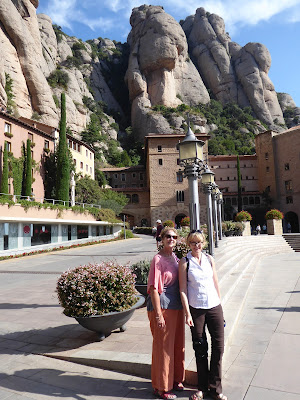Today our ship docked in the port city of Cadiz, and we took the bus to visit Sevilla. What a beautiful, romantic city this is. I just wish we'd had more time than a half a day. This city is definitely worth a longer visit, as there's so much to see and take in.
We began in an unusual way (but maybe not so unusual for an architect!). We started with a visit to a recent addition to the city, called the Metropol Parasol. This fascinating and huge mushroom-like structure covers an entire plaza, and even extends across the street to engage another block.
On the ground floor, there's a public market with fruits and veg, fresh fish, meat, cheese and more. Like the historic markets we saw in Barcelona, but in a modern setting. Above that is a big plaza, and above that the Parasol. You can even get up onto the roof, where there's a cafe and viewing platform, but we couldn't figure out how to get up there.
The neighborhood is great, and we had a lovely breakfast overlooking the plaza.
From there, we walked through the narrow shopping streets of Santa Cruz, the historic Jewish quarter. Sadly, the thriving Jewish community of Sevilla was lost during the inquisition in the early 16th century, when the Jews had to leave, convert, or be killed, along with the Moors. It's now a bustling network of very narrow streets lined with beautiful buildings and shops, that lead from this plaza to the center of town.
The central square was filled with horse drawn carriages, and if we'd had more time, it would have been great to tour the city this way, but that will have to wait until another visit.
Our next stop was the cathedral, which is the third largest in the world. It really was quite enormous, and very, very crowded. This is another site where I'd recommend buying tickets in advance over the internet, because it took about a half hour in line to get inside. But it was well worth it.
Even the moon made a showing, but left because the line was too long!
The interior is breathtaking. The space is incredibly tall, and, while most of the structure is very simple, the center area is crowned with beautiful late Gothic vaulting.
We were lucky to see the light come streaming in too.
The altarpiece is the largest gold structure i've ever seen. the opulence of those days was incredible, thanks to the plundering of the American continent.
I love climbing up towers to see the views. This one was great. It was built way before the rest of the cathedral, as the minaret of the mosque that originally stood at this site. The cloister of the church is also a part of the original mosque, with a great system for running water into fountains through the whole space.
The views from the tower were great, and it was an interesting one, in that you accessed the top via 35 ramps rather than a spiral stair. I got there just in time for the bells to ring, and that was quite an eye (and ear!) opener.





















































